Abstract
Candida lusitaniae has been an infrequently reported opportunistic pathogen. Most previously reported cases of serious infection caused by this organism have proven fatal and were associated with amphotericin resistance of the organism. We report two patients with hematologic malignancies undergoing cytotoxic chemotherapy who developed fungemia with this organism while they were granulocytopenic. The organisms isolated from each patient were fully susceptible and were treated successfully with amphotericin B. When isolated from an immunocompromised host, C. lusitaniae should be considered an opportunistic pathogen and undergo antifungal susceptibility testing. Amphotericin B should be considered the drug of choice, but a poor clinical response may be indicative of a resistant isolate.
Full text
PDF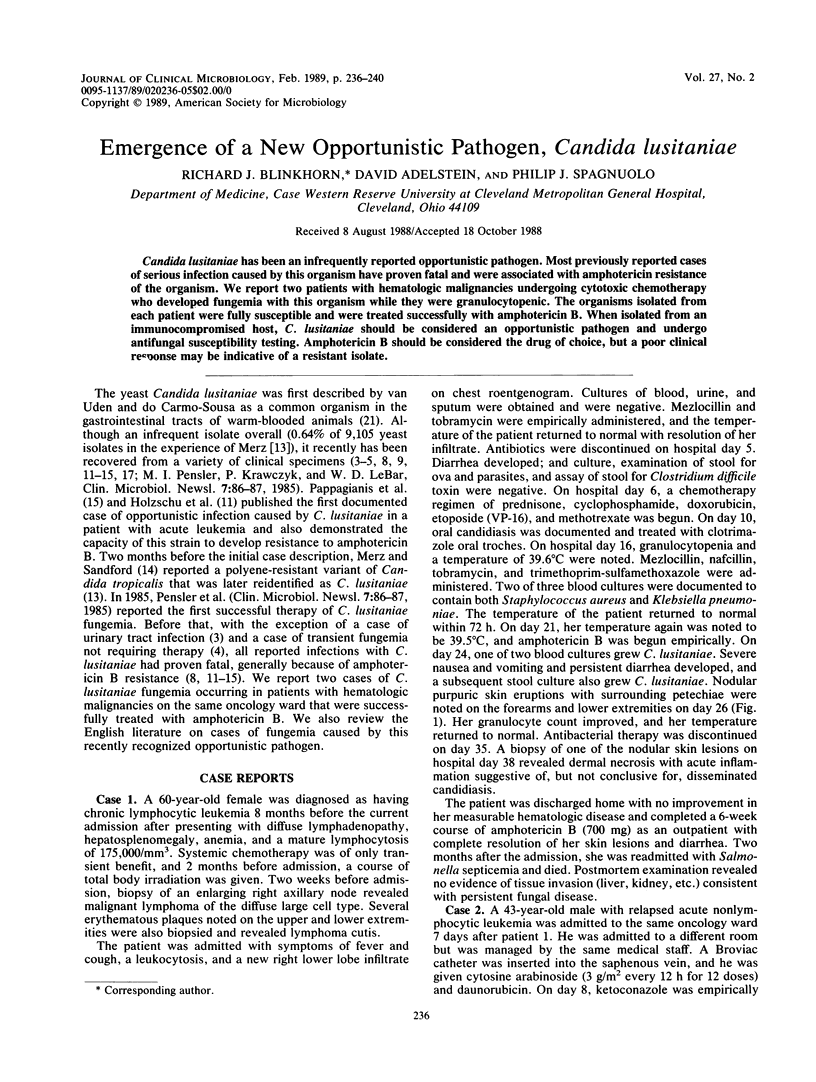
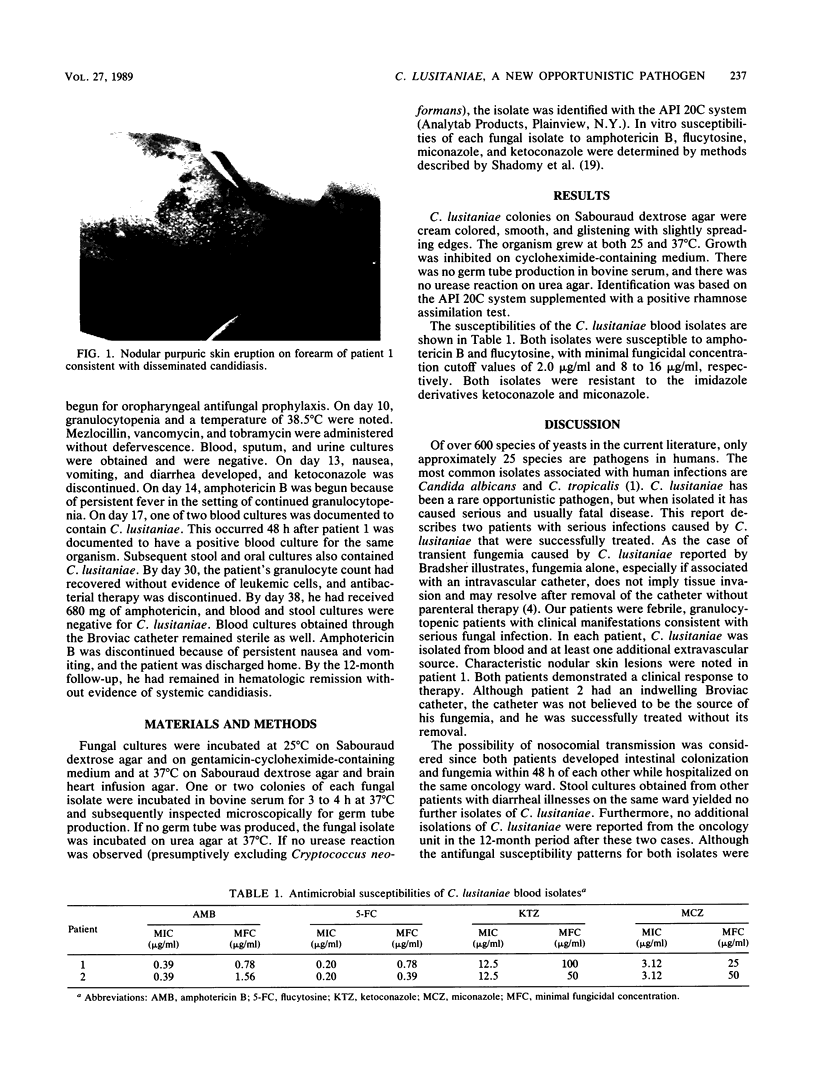
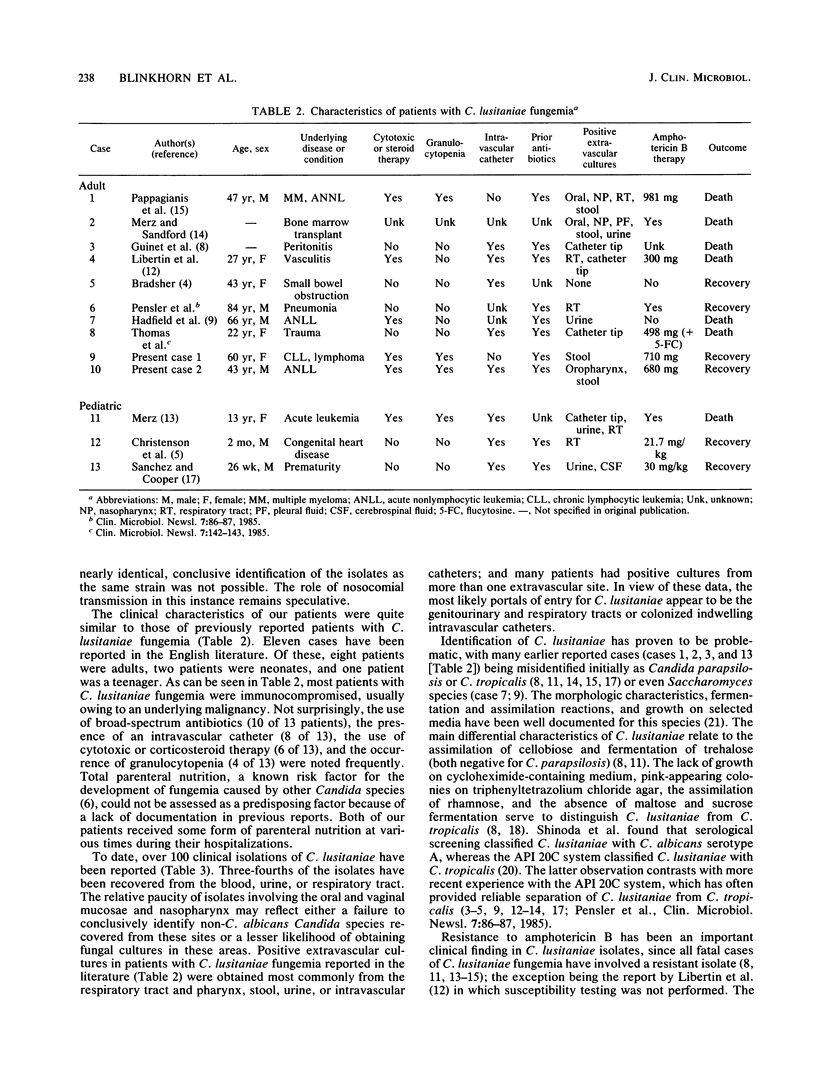
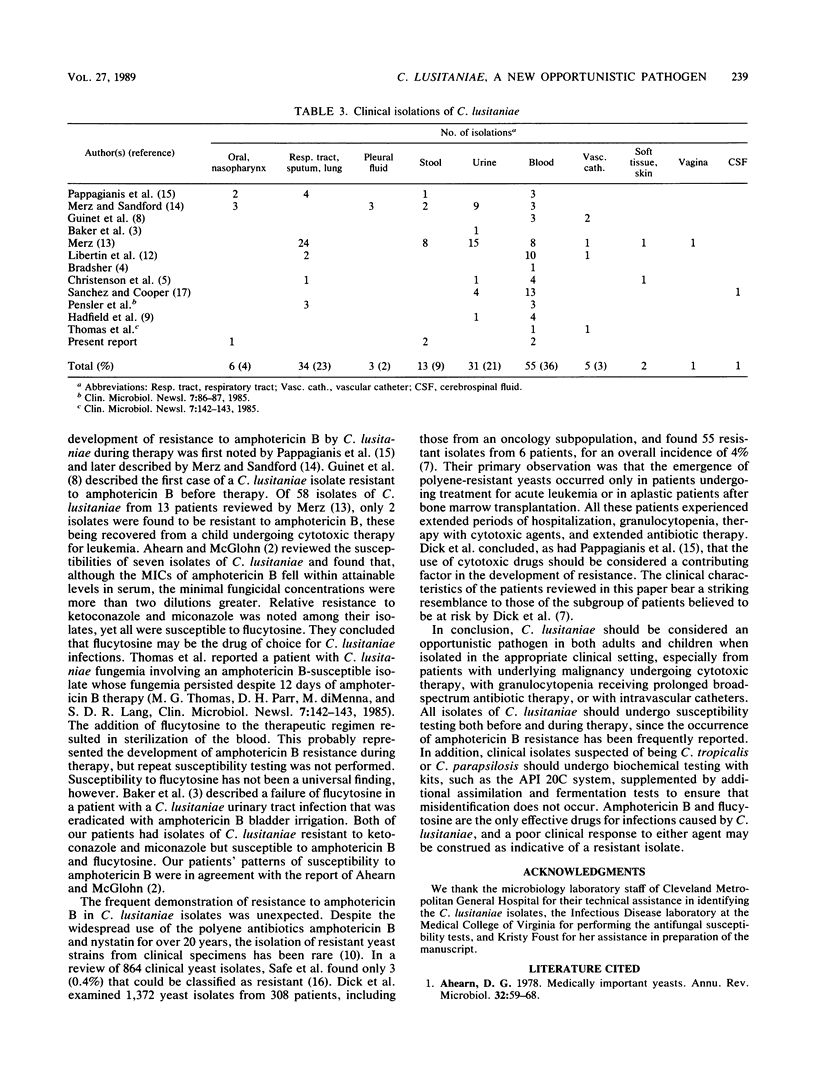
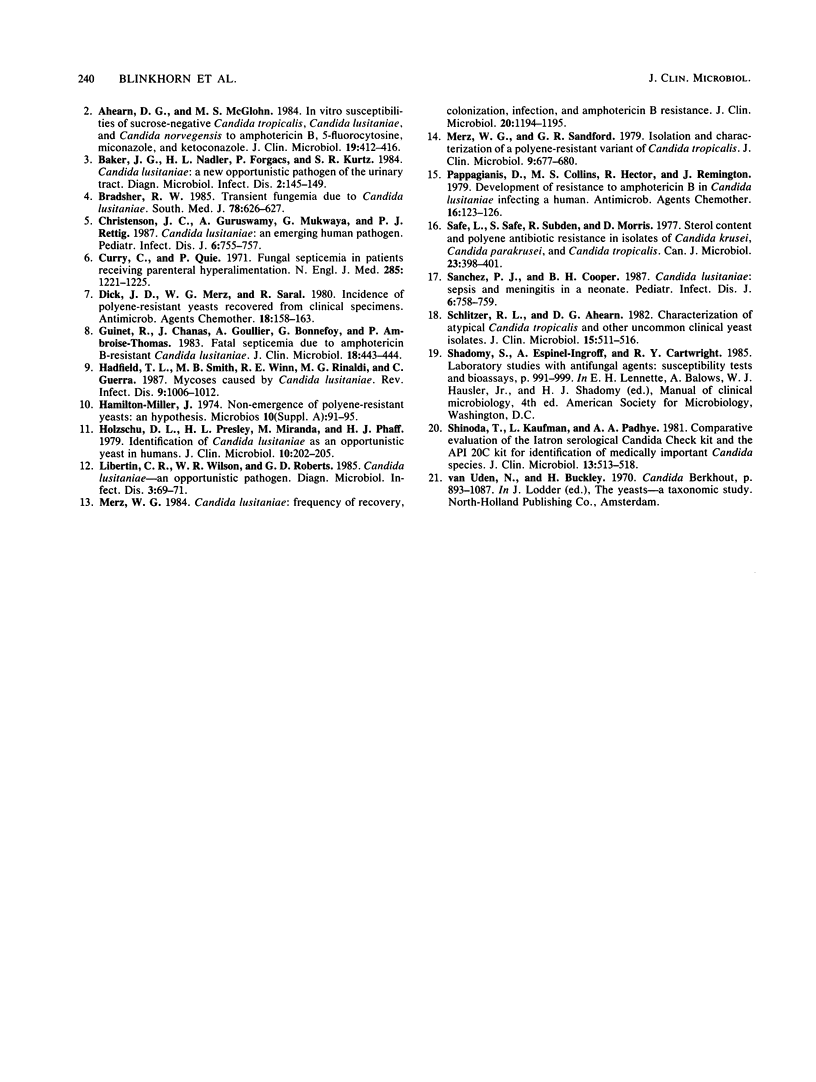
Images in this article
Selected References
These references are in PubMed. This may not be the complete list of references from this article.
- Ahearn D. G., McGlohn M. S. In vitro susceptibilities of sucrose-negative Candida tropicalis, Candida lusitaniae, and Candida norvegensis to amphotericin B, 5-fluorocytosine, miconazole, and ketoconazole. J Clin Microbiol. 1984 Mar;19(3):412–416. doi: 10.1128/jcm.19.3.412-416.1984. [DOI] [PMC free article] [PubMed] [Google Scholar]
- Ahearn D. G. Medically important yeasts. Annu Rev Microbiol. 1978;32:59–68. doi: 10.1146/annurev.mi.32.100178.000423. [DOI] [PubMed] [Google Scholar]
- Baker J. G., Nadler H. L., Forgacs P., Kurtz S. R. Candida lusitaniae: a new opportunistic pathogen of the urinary tract. Diagn Microbiol Infect Dis. 1984 Apr;2(2):145–149. doi: 10.1016/0732-8893(84)90010-5. [DOI] [PubMed] [Google Scholar]
- Bradsher R. W., White F. J. Transient fungemia due to Candida lusitaniae. South Med J. 1985 May;78(5):626–627. doi: 10.1097/00007611-198505000-00035. [DOI] [PubMed] [Google Scholar]
- Christenson J. C., Guruswamy A., Mukwaya G., Rettig P. J. Candida lusitaniae: an emerging human pathogen. Pediatr Infect Dis J. 1987 Aug;6(8):755–757. [PubMed] [Google Scholar]
- Curry C. R., Quie P. G. Fungal septicemia in patients receiving parenteral hyperalimentation. N Engl J Med. 1971 Nov;285(22):1221–1225. doi: 10.1056/NEJM197111252852203. [DOI] [PubMed] [Google Scholar]
- Dick J. D., Merz W. G., Saral R. Incidence of polyene-resistant yeasts recovered from clinical specimens. Antimicrob Agents Chemother. 1980 Jul;18(1):158–163. doi: 10.1128/aac.18.1.158. [DOI] [PMC free article] [PubMed] [Google Scholar]
- Guinet R., Chanas J., Goullier A., Bonnefoy G., Ambroise-Thomas P. Fatal septicemia due to amphotericin B-resistant Candida lusitaniae. J Clin Microbiol. 1983 Aug;18(2):443–444. doi: 10.1128/jcm.18.2.443-444.1983. [DOI] [PMC free article] [PubMed] [Google Scholar]
- Hadfield T. L., Smith M. B., Winn R. E., Rinaldi M. G., Guerra C. Mycoses caused by Candida lusitaniae. Rev Infect Dis. 1987 Sep-Oct;9(5):1006–1012. doi: 10.1093/clinids/9.5.1006. [DOI] [PubMed] [Google Scholar]
- Hamilton-Miller J. M. Non-emergence of polyene-resistant yeasts: an hypothesis. Microbios. 1974 Jun-Jul;10A SUPPL(41):91–95. [PubMed] [Google Scholar]
- Holzschu D. L., Presley H. L., Miranda M., Phaff H. J. Identification of Candida lusitaniae as an opportunistic yeast in humans. J Clin Microbiol. 1979 Aug;10(2):202–205. doi: 10.1128/jcm.10.2.202-205.1979. [DOI] [PMC free article] [PubMed] [Google Scholar]
- Libertin C. R., Wilson W. R., Roberts G. D. Candida lusitaniae--an opportunistic pathogen. Diagn Microbiol Infect Dis. 1985 Jan;3(1):69–71. doi: 10.1016/0732-8893(85)90069-0. [DOI] [PubMed] [Google Scholar]
- Merz W. G. Candida lusitaniae: frequency of recovery, colonization, infection, and amphotericin B resistance. J Clin Microbiol. 1984 Dec;20(6):1194–1195. doi: 10.1128/jcm.20.6.1194-1195.1984. [DOI] [PMC free article] [PubMed] [Google Scholar]
- Merz W. G., Sandford G. R. Isolation and characterization of a polyene-resistant variant of Candida tropicalis. J Clin Microbiol. 1979 Jun;9(6):677–680. doi: 10.1128/jcm.9.6.677-680.1979. [DOI] [PMC free article] [PubMed] [Google Scholar]
- Pappagianis D., Collins M. S., Hector R., Remington J. Development of resistance to amphotericin B in Candida lusitaniae infecting a human. Antimicrob Agents Chemother. 1979 Aug;16(2):123–126. doi: 10.1128/aac.16.2.123. [DOI] [PMC free article] [PubMed] [Google Scholar]
- Safe L. M., Safe S. H., Subden R. E., Morris D. C. Sterol content and polyene antibiotic resistance in isolates of Candida krusei, Candida parakrusei, and Candida tropicalis. Can J Microbiol. 1977 Apr;23(4):398–401. doi: 10.1139/m77-058. [DOI] [PubMed] [Google Scholar]
- Sanchez P. J., Cooper B. H. Candida lusitaniae: sepsis and meningitis in a neonate. Pediatr Infect Dis J. 1987 Aug;6(8):758–759. [PubMed] [Google Scholar]
- Schlitzer R. L., Ahearn D. G. Characterization of atypical Candida tropicalis and other uncommon clinical yeast isolates. J Clin Microbiol. 1982 Mar;15(3):511–516. doi: 10.1128/jcm.15.3.511-516.1982. [DOI] [PMC free article] [PubMed] [Google Scholar]
- Shinoda T., Kaufman L., Padhye A. A. Comparative evaluation of the Iatron serological Candida check kit and the API 20C kit for identification of medically important Candida species. J Clin Microbiol. 1981 Mar;13(3):513–518. doi: 10.1128/jcm.13.3.513-518.1981. [DOI] [PMC free article] [PubMed] [Google Scholar]



